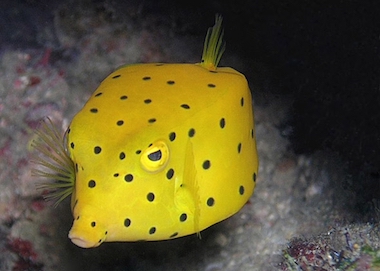866-295-4143, fbns@wayoflife.org

Mercedes-Benz built a concept car from its research into the tropical boxfish (Ostracion cubicus).
“Biomimetic materials research is becoming a rapidly growing and enormously promising field” (P. Fratzl, “Biomimetic materials research,” Journal of the Royal Society, 2007, cited from Jonathan Sarfati, By Design, p. 113).
“The act of copying nature to address a design problem isn’t new, but over the past decade, the practice has moved from obscure scientific journals and into the mainstream. It even has a name: biomimicry. Its advocates view nature as not just a resource to be mined but also a mentor” (“Back to Nature,” Reader’s Digest, June-July 2011, p. 166).
The very existence of this scientific field is a powerful witness to the fact that “nature” is intelligently designed.
John McMasters, an aeronautics engineer with Boeing, says that lessons learned from nature will play an increasing role in new aircraft (“Flying Creatures May Help Create Aviation of Future,” USA Today, Feb. 13, 2007).
In 2012 the San Diego Zoo established a “Centre for Bioinspiration” to serve as “a product incubator that is intended to help advance biologically inspired products.” According to a report commissioned by the zoo in 2011, biomimicry could generate as much as $300 billion annually to the U.S. economy by 2025.
Mercedes-Benz built a concept car from its research into the tropical boxfish (Ostracion cubicus). They found that there is nothing clunky about the clunky-looking fish. It has a drag coefficient of just 0.06, “startingly close to the ideal 0.04 of a water droplet” (“Fish-inspired Car,” Popular Science, Aug. 16, 2005). “Like the droplet, the boxfish´s face is small in proportion to its overall length, and its streamlined surfaces encourage air to move over it without creating the turbulence that robs aerodynamic efficiency.”
Edward Kelley copied the human eye’s design to create a camera that has 70 times better clarity and resolution in dealing with lens flare. The human eye “ingeniously” uses liquid to fill the gap between the lens and retina to overcome this problem.
University of Florida engineering professor Anthony Brennan developed Sharklet by studying how shark’s skin prevents fouling by algae and barnacles via a microscopic toothlike pattern of the scales. By mimicking these amazingly complex scales, Sharklet reduces fouling on ships by 85% (Reader’s Digest, June-July 2011, p. 167).
Japanese engineer Eiji Nakatsu patterned the nose of a bullet train after the design of the kingfisher’s beak (Reader’s Digest, p. 168). This made it possible for the train to enter narrow tunnels at high speed without producing a sonic boom.
Fish’s WhalePower Corporation markets fan blades that move 25% more air and use 20% less electricity than conventional fan blades by mimicking the bumps on the flipper of the humpback whale (Reader’s Digest, p. 170). Biologist Frank Fish discovered that the flipper bumps, or tubercles, reduce drag and improve aerodynamics, which is contrary to conventional engineering wisdom that says that a smooth leading edge reduces drag.
Architect Mick Pearce created the non-air-conditioned cooling system of a building in Harare, Zimbabwe, by mimicking the design of termite mounds. “The insects cooled their mud homes using an INGENIOUS system that catches breezes at the base of the mounds” (Reader’s Digest, p. 169).
Engineers are studying gecko foot hairs for the design of space-age adhesives. “Geckos can do things that we just can’t do with current robotics and adhesive technology” (K. Autumn, San Francisco Chronicle, June 19, 2000). A team of scientists led by Andre Geim, of the University of Manchester, invented a self-cleaning adhesive tape modeled on the gecko’s foot (Jonathan Sarfati, By Design, p. 108).
The deep-sea sponge Euplectella grows glassy fibers that are so superior to man-made fibers that Geri Richmond of the University of Oregon says, “It’s such a wonderful example of how exquisite nature is as a designer and builder of complex systems. We’re in the stone age compared to nature” (“Sponge Has Natural Glass Fiber Optics,” San Francisco Chronicle, Aug. 8, 2000, p. A2).
Mirasol display technology generates colors for mobile phone displays by mimicking the interference of reflected light by microscopic scales on the iridescent surface of the morpho butterfly’s wings (“Amid Wave of Bioinspiration,” xconomy.com, Aug. 29, 2012).
Isn’t blind evolution amazing! It creates “ingenious,” “exquisite,” “complex” designs that cause the most brilliant scientists and engineers to marvel.
Engineers are also learning from the cell’s tiny machines.
“The biological cell is equipped with a variety of molecular machines that perform complex mechanical tasks such as cell division or intracellular transport. One can envision employing these biological motors in artificial environments. ... the sheer availability of an entire ready-to-use toolbox of nanosized biological motors is a great opportunity that calls for exploration. ... At the moment, we can only dream of constructing machines of similar size that possess just a fraction of the functionality of these natural wonders” (M. van den Heuvel, and C. Dekker, “Motor Proteins at Work for Nanotechnology,” Science, 2007, cited by Sarfati, By Design, p. 143).
The study of moth eyes has enabled researchers in Japan (led by Noboru Yamada of Nagaoka University of Technology) to create a new film for covering solar cells that can cut down on reflected light and help capture more power from the sun. Moth eyes are covered with a water-repellent, antireflective coating that makes their eyes among the least reflective surfaces in nature and helps them see in the dark as well as hide from predators (“Insect Eyes Inspire Improved Solar Cells,” Jan. 20, 2011, Physorg.com).
A team of engineers doing biomimetic research into the bombardier beetle won a prestigious award on November 25, 2010. The team, led by Dr. Andy McIntosh, professor of thermodynamic and combustion theory at the University of Leeds, received the Outstanding Contribution to Innovation and Technology title at the Times Higher Education awards in London. They are studying the beetle’s incredibly complicated and amazing defense mechanism that consists of a toxic steam it can blast up to eight inches through an aim-able turret. A news report says the research “could inspire new types of nebulisers, needle-free injections, fire extinguishers and powerful fuel injection systems” (“Scientist Wins Prestigious Research Award,” BBC, Dec. 22, 2010). Dr. McIntosh, who is a creationist, said:
“I believe there is much more of nature’s secrets that we could learn from our great Creator if we looked with an eye to see design. ... it was such an experiment and entrepreneurial spirit that led Wilbur and Orville Wright 107 years ago this month, to successfully copy the wing control of birds and so fly a warp wing controlled flying machine to fly along Kitty Hawk beach, in North Carolina” (The Times 2010 award website).
Answers in Genesis observes: “So much for those secularists who continually claim that real scientists can’t be creationists. Dr. McIntosh has spoken for AiG many times in the UK on creation, plus his own speaking engagements all over the world.”
____________
The above is from SEEING THE NON-EXISTENT: EVOLUTION’S MYTHS AND HOAXES. ISBN 1-58318-002-8. This book is designed both as a stand alone title as well as a companion to the apologetics course AN UNSHAKEABLE FAITH. The contents are as follows: Canals on Mars, Charles Darwin and His Granddaddy, Thomas Huxley: Darwin’s Bulldog, Ernst Haeckel: Darwin’s German Apostle, Icons of Evolution, Icons of Creation, The Ape-men, Predictions, Questions for Evolutionists, Darwinian Gods, Darwin’s Social Influence. The ICONS OF EVOLUTION that we refute include mutations, the fossil record, homology, the peppered moth, Darwin’s finches, the fruit fly, vestigial organs, the horse series, the embryo chart, the Miller experiment, Archaeopteryx, bacterial resistance, the big bang, and billions of years. The ICONS OF CREATION that we examine include the monarch butterfly, the trilobite, the living cell, the human eye, the human brain, the human hand, blood clotting, the bird’s flight feather, bird migration, bird song, harmony and symbiosis, sexual reproduction, living technology, the dragonfly, the bee, and the bat. The section on APE-MEN deals with Cro-Magnon, Neanderthal, Java Man, Piltdown Man, Nebraska Man, Peking Man, Lucy, Ardi, Ida, among others. The section on PREDICTIONS considers 29 predictions made by Biblical creationism, such as the universe will behave according to established laws, the universe will be logical, and there will be a vast unbridgeable gulf between man and the animal kingdom. DARWINIAN GODS takes a look at inventions that evolutionists have devised to avoid divine Creation, such as panspermia and aliens, self-organization, and the multiverse. 608 pages.
- Receive these reports by email
- www.wayoflife.org
______________________
Sharing Policy: Much of our material is available for free, such as the hundreds of articles at the Way of Life web site. Other items we sell to help fund our expensive literature and foreign church planting ministries. Way of Life's content falls into two categories: sharable and non-sharable. Things that we encourage you to share include the audio sermons, O Timothy magazine, FBIS articles, and the free eVideos and free eBooks. You are welcome to make copies of these at your own expense and share them with friends and family. You may also post parts of reports and/or entire reports to websites, blogs, etc as long as you give proper credit (citation). A link to the original report is very much appreciated as the reports are frequently updated and/or expanded. Things we do not want copied and distributed are "Store" items like the Fundamental Baptist Digital Library, print editions of our books, electronic editions of the books that we sell, the videos that we sell, etc. The items have taken years to produce at enormous expense in time and money, and we use the income from sales to help fund the ministry. We trust that your Christian honesty will preserve the integrity of this policy. "For the scripture saith, Thou shalt not muzzle the ox that treadeth out the corn. And, The labourer is worthy of his reward" (1 Timothy 5:18). Questions? support@wayoflife.org
Goal:Distributed by Way of Life Literature Inc., the Fundamental Baptist Information Service is an e-mail posting for Bible-believing Christians. Established in 1974, Way of Life Literature is a fundamental Baptist preaching and publishing ministry based in Bethel Baptist Church, London, Ontario, of which Wilbert Unger is the founding Pastor. Brother Cloud lives in South Asia where he has been a church planting missionary since 1979. Our primary goal with the FBIS is to provide material to assist preachers in the edification and protection of the churches.
Offering: Offerings are welcome if you care to make one. If you have been helped and/or blessed by our material offerings can be mailed or made online with with Visa, Mastercard, Discover, or Paypal. For information see: www.wayoflife.org/about/makeanoffering.html.





